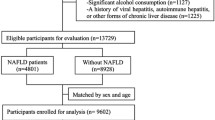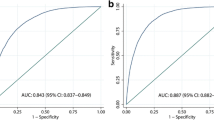Abstract
Aims
The ZJU index is a novel model for detecting non-alcoholic fatty liver disease (NAFLD) that it is calculated based on combination of the body mass index, fasting plasma glucose, triglycerides, and the serum alanine aminotransferase-to-aspartate transaminase ratio. We aimed to evaluate the diagnostic accuracy of the ZJU index in detecting NAFLD in the Chinese population.
Methods
This was a cross-sectional study. Anthropometric measurements, laboratory data, and ultrasonography features were collected through a standard protocol. The ZJU index, fatty liver index, hepatic steatosis index, lipid accumulation product, and visceral adiposity index were calculated. Then the predictive values of the five indices were compared according to the area under receiver-operating characteristic curve (AUROC) values.
Results
A total of 19,804 participants were recruited, of whom 7324 participants were diagnosed with NFALD and 12,480 subjects were regarded as controls. The AUROC value for NAFLD identification by the ZJU index was 0.925 (95% confidence interval [CI]: 0.919–0.931), which was significantly higher than the values for the other four models (P < 0.001). Furthermore, from age 31 years to >60 years, the AUROC for the ZJU increased from 87.1 to 95.4%, values which were also greater than those for the other four indices. Analysis by sex also showed that the performance of the ZJU index in males and females was better than that of the other four indices.
Conclusions
The ZJU index is an accurate and easy to employ tool for identifying NAFLD in the general Chinese population.


Similar content being viewed by others
Change history
26 September 2019
In paragraph Index calculation formulae
26 September 2019
In paragraph Index calculation formulae
References
Rinella ME (2015) Nonalcoholic fatty liver disease: a systematic review. JAMA 313:2263–2273
Goh GB, McCullough AJ (2016) Natural history of nonalcoholic fatty liver disease. Dig Dis Sci 61:1226–1233
Vernon G, Baranova A, Younossi ZM (2011) Systematic review: the epidemiology and natural history of non-alcoholic fatty liver disease and non-alcoholic steatohepatitis in adults. Aliment Pharmacol Ther 34:274–285
Clark JM, Brancati FL, Diehl AM (2003) The prevalence and etiology of elevated aminotransferase levels in the United States. Am J Gastroenterol 98:960–967
Fan JG, Farrell GC (2009) Epidemiology of non-alcoholic fatty liver disease in China. J Hepatol 50:204–210
Chalasani N, Younossi Z, Lavine JE et al (2012) The diagnosis and management of non-alcoholic fatty liver disease: practice guideline by the American Association for the Study of Liver Diseases, American College of Gastroenterology, and the American Gastroenterological Association. Hepatology 55:2005–2023
Hernaez R, Lazo M, Bonekamp S et al (2011) Diagnostic accuracy and reliability of ultrasonography for the detection of fatty liver: a meta-analysis. Hepatology 54:1082–1090
Dasarathy S, Dasarathy J, Khiyami A et al (2009) Validity of real time ultrasound in the diagnosis of hepatic steatosis: a prospective study. J Hepatol 51:1061–1067
Joy D, Thava VR, Scott BB (2003) Diagnosis of fatty liver disease: is biopsy necessary? Eur J Gastroenterol Hepatol 15:539–543
Machado MV, Cortez-Pinto H (2013) Noninvasive diagnosis of non-alcoholic fatty liver disease. A critical appraisal. J Hepatol 58:1007–1019
Bedogni G, Bellentani S, Miglioli L et al (2006) The fatty liver index: a simple and accurate predictor of hepatic steatosis in the general population. BMC Gastroenterol 6:33
Gastaldelli A, Kozakova M, Hojlund K et al (2009) Fatty liver is associated with insulin resistance, risk of coronary heart disease, and early atherosclerosis in a large European population. Hepatology 49:1537–1544
Calori G, Lattuada G, Ragogna F et al (2011) Fatty liver index and mortality: the Cremona study in the 15th year of follow-up. Hepatology 54:145–152
Lee JH, Kim D, Kim HJ et al (2010) Hepatic steatosis index: a simple screening tool reflecting nonalcoholic fatty liver disease. Dig Liver Dis 42:503–508
Kahn HS (2005) The “lipid accumulation product” performs better than the body mass index for recognizing cardiovascular risk: a population-based comparison. BMC Cardiovasc Disord 5(1):26
Amato MC, Giordano C, Galia M et al (2010) Visceral adiposity index: a reliable indicator of visceral fat function associated with cardiometabolic risk. Diabetes Care 33:920–922
Wang J, Xu C, Xun Y et al (2015) ZJU index: a novel model for predicting nonalcoholic fatty liver disease in a Chinese population. Sci Rep 5:16494
Xu C, Yu C, Ma H, Xu L et al (2013) Prevalence and risk factors for the development of nonalcoholic fatty liver disease in a nonobese Chinese population: the Zhejiang Zhenhai Study. Am J Gastroenterol 108:1299–1304
Yu C, Xu C, Xu L et al (2012) Serum proteomic analysis revealed diagnostic value of hemoglobin for nonalcoholic fatty liver disease. J Hepatol 56:241–247
Fan JG, Jia JD, Li YM et al (2011) Guidelines for the diagnosis and management of nonalcoholic fatty liver disease: update 2010 published in Chinese on Chinese Journal of Hepatology 2010; 18:163–166. J Dig Dis 12:38–44
Petta S, Amato M, Cabibi D et al (2010) Visceral adiposity index is associated with histological findings and high viral load in patients with chronic hepatitis C due to genotype 1. Hepatology 52:1543–1552
DeLong ER, DeLong DM, Clarke-Pearson DL (1988) Comparing the areas under two or more correlated receiver operating characteristic curves: a nonparametric approach. Biometrics 44:837–845
European Association for the Study of the Liver (EASL), European Association for the Study of Diabetes (EASD), European Association for the Study of Obesity (EASO)(2016)EASL-EASD-EASO Clinical Practice Guidelines for the management of non-alcoholic fatty liver disease. J Hepatol 64:1388–1402
Adams LA, Angulo P, Lindor KD (2005) Nonalcoholic fatty liver disease. CMAJ 172:899–905
Author information
Authors and Affiliations
Corresponding author
Ethics declarations
Conflict of interest
Linman Li, Wenyi You, and Wei Ren declare that they have no conflict of interest.
Human and animal rights disclosure
All procedures involving human participants were performed in accordance with the ethical standards of the First Affiliated Hospital of Chongqing Medical University and with the 1964 Declaration of Helsinki and its later amendments or comparable ethical standards.
Informed consent
Informed consent was obtained from all individual participants included in the study.
Additional information
Managed by Antonio Secchi.
Electronic supplementary material
Below is the link to the electronic supplementary material.
Rights and permissions
About this article
Cite this article
Li, L., You, W. & Ren, W. The ZJU index is a powerful index for identifying NAFLD in the general Chinese population. Acta Diabetol 54, 905–911 (2017). https://doi.org/10.1007/s00592-017-1024-8
Received:
Accepted:
Published:
Issue Date:
DOI: https://doi.org/10.1007/s00592-017-1024-8




